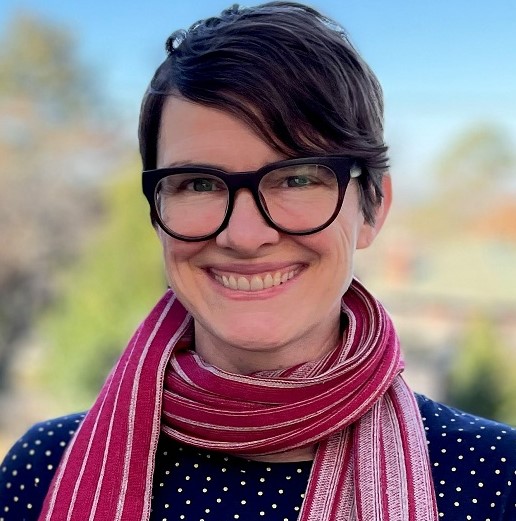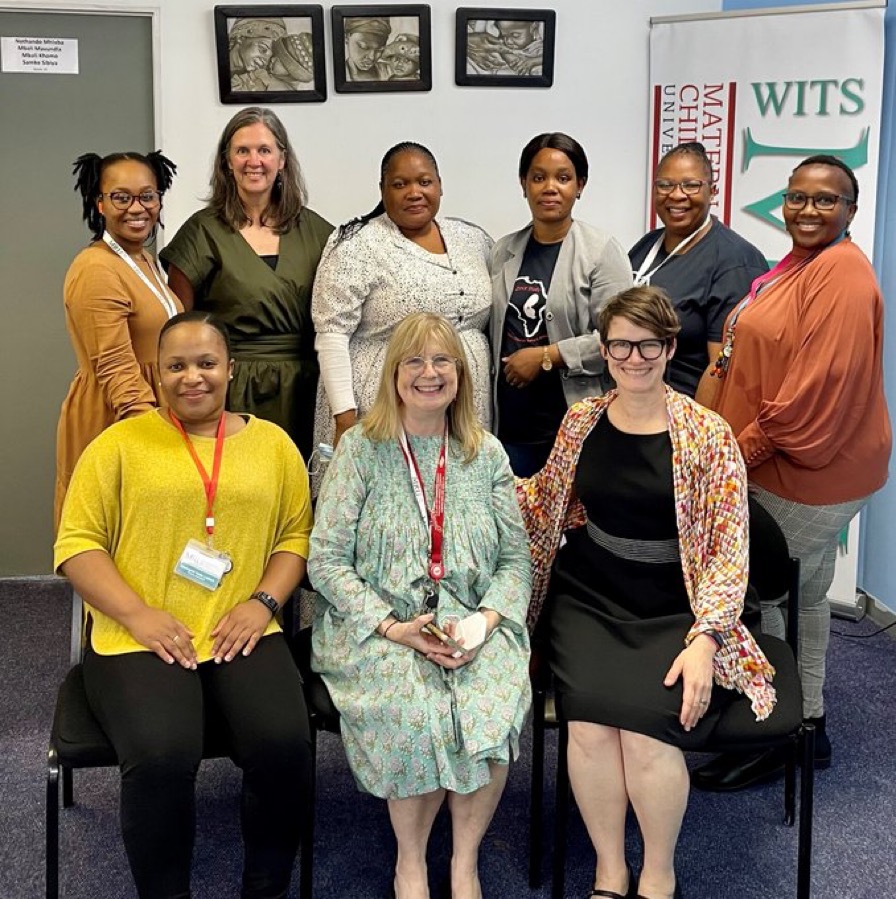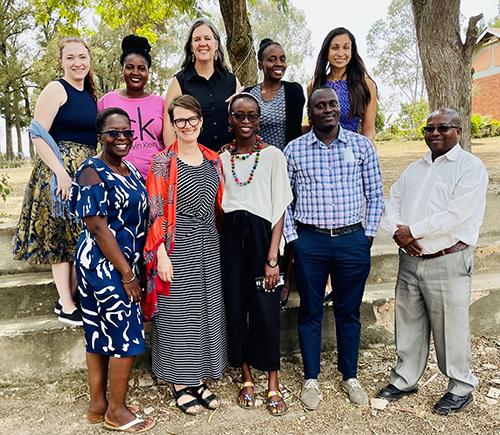 Lynn Matthews, M.D., MPH, is the associate director for Research and Partnerships for the Mary Heersink Institute for Global Health and an associate professor in the UAB Division of Infectious Diseases. Her work centers around sexual health in the context of the human immunodeficiency virus (HIV), HIV prevention, and the importance of reproductive rights for people living with HIV in Uganda, South Africa, and the United States.
Lynn Matthews, M.D., MPH, is the associate director for Research and Partnerships for the Mary Heersink Institute for Global Health and an associate professor in the UAB Division of Infectious Diseases. Her work centers around sexual health in the context of the human immunodeficiency virus (HIV), HIV prevention, and the importance of reproductive rights for people living with HIV in Uganda, South Africa, and the United States.
Matthews completed her undergraduate education at Swarthmore College, where she worked in a lab conducting basic science research on circadian rhythms. The lab felt isolated, and she missed working with people and in communities. One of her basic science mentors encouraged her to merge her science skills and commitment to public service through medicine.
“I sought out a semester as a health educator at a clinic in Miami,” said Matthews. “It was the mid-nineties, and HIV was the latest plague to assault the community. The needs of the clinic led me to obtain training as an HIV counselor, and I became engrossed with the unique medical and psychosocial challenges of caring for the patients we diagnosed. There, as I worked with devoted doctors and a clinic team) who empowered vulnerable people with knowledge of, and control over, their bodies and lives, I could not imagine a richer or more rewarding career.”
We sat down with Dr. Matthews to gain insight into her life and work in global health.
 Lynn Matthews, M.D., MPHQ: What led you to your focus area?
Lynn Matthews, M.D., MPHQ: What led you to your focus area?
I attended medical school in Miami, Florida, where my clinical work and research experiences continued to focus on HIV. As a resident in Boston, I took advantage of opportunities to do global health electives in order to learn more about HIV care in HIV-endemic settings. During an elective to provide clinical care in Rwanda, I met a community health worker whom I will call Pierre.
Having lost their families in the Rwandan genocide, Pierre and his wife had spent years trying to piece together the extended family they had once enjoyed. They desperately wanted to have their own children. As the HIV-positive member of a serodifferent couple, where one person is HIV-positive and the other is HIV-negative, and a community health worker in Rwanda, Pierre knew that this could put his wife and future children at risk for HIV. Through much consideration, they sought out a surrogate living with HIV, and eventually, his partner also become pregnant, and she and both babies remained HIV seronegative. However, the challenges and stresses they faced in trying to meet their reproductive goals could have been minimized with a supportive healthcare team.
Pierre asked us to work with him to develop a program for counseling serodifferent couples choosing to have children. Together with a nurse and a social worker, Pierre and I met with groups of couples and developed a program to address some of the complex issues they faced.
A few years later, Dr. Janet Giddy was my clinic mentor at McCord Hospital in KwaZulu-Natal, South Africa, where I spent a year as an internist between residency and infectious disease (ID) fellowship. There I continued to provide care to people living with HIV who wanted to have children – but most of their providers were uncertain about how to safely support their goals. Janet invited me to a meeting with the counseling staff, and they talked about the reproductive needs of the clients at the clinic and how they were not being met. It was the same story I had heard in Rwanda, and I started to see an important gap in clinical care for people living with or partnered with someone living with HIV. When I returned to Boston to start my Infectious Diseases fellowship, I met Dr. David Bangsberg, who became my research mentor and helped me develop a research program around providing HIV prevention and care to people living with HIV who want to have children.
Q: What are the big issues in your focus area?
My work in Uganda and South Africa seeks to develop, test, and implement programs to reduce sexual HIV transmission in the context of reproductive goals in HIV-endemic settings, including Pre-Exposure Prophylaxis (PrEP) use among women planning for and with pregnancy and anti-retroviral therapy (ART) uptake and viral suppression among men with HIV who want to have children. My ‘status neutral’ work in the southeastern U.S. adapts and implements strategies to promote HIV testing, PrEP uptake, and linkage to HIV care.
Q: How did you connect with UAB?
Dr. Jeanne Marrazzo suggested I come to Birmingham to give a talk while I was looking for a new job. UAB is a real powerhouse in both HIV and sexually transmitted infection (STI) research, and the ID division is full of smart, engaged faculty who collaborate with other incredible faculty across schools and beyond. Some of the biggest challenges in preventing and treating HIV in the U.S. are here, in the U.S. Southeast. The opportunity to apply lessons learned from my work in HIV in Uganda and South Africa to domestic issues in my home country was very exciting and compelling. Plus, the Heersink School of Medicine is in a phase of growing global health activities. It turned out to be a great fit for my husband, who is a geriatric psychiatrist clinician educator at UAB, as well, and here we are!
 ZINK Study Team, MatCH Research Unit, Durban, South Africa Q: How did you connect with your global partners?
ZINK Study Team, MatCH Research Unit, Durban, South Africa Q: How did you connect with your global partners?
While I was a Schwartz Global Health Fellow through Massachusetts General Hospital, I worked as a medical consultant and outpatient HIV provider at McCord Hospital in Durban, South Africa. I did a small research project that year and came back for the second year of my infectious disease fellowship to conduct qualitative research on the reproductive goals of people living with HIV. I really got to know my partners and what questions might be relevant to the population by being there and taking care of patients in the hospital and in the clinic.
My research mentor during my ID fellowship, David Bangsberg, had a robust research program in Uganda. He encouraged me to visit the research site in Mbarara, Uganda, and through meetings with partners there, I realized the questions I was asking about HIV prevention and care in the context of reproductive health were very relevant to people living with HIV in Uganda. I was able to partner with researchers there and secured funding to better understand the local context and needs – by partnering with local epidemiologists and physicians and research teams at the Mbarara University of Science and Technology I have become part of a vibrant and engaged research collaboration.
Q: What is innovative about your work?
Reproductive health for PWH was innovative when I began my career. Thanks to the work I have helped lead with many other contributors, this is now the standard of care. The science of HIV evolved, too, and the availability of very effective HIV prevention strategies, such as pre-exposure prophylaxis for people exposed to HIV and treatment as prevention for people living with HIV has simplified the approach to helping couples safely meet reproductive goals. Some of my projects now focus on developing programs to make HIV pre-exposure prophylaxis, or PrEP, accessible and feasible for women planning for, with, or post-pregnancy.
My work in Alabama is focused on implementing evidence-based interventions to improve our HIV care cascade and the innovation there is in finding ways to work creatively and effectively with our community partners to end the HIV epidemic. Aadia Rana, Latesha Elopre, Mirjam Kempf, and others at UAB are doing creative and important work in this space, and I’m fortunate to partner with and learn from them.
Q: What has been the impact of your work?
I think the biggest contribution to date has been identifying gaps in HIV prevention (and care) for people exposed to HIV while trying for pregnancy (periconception), and by doing so, we are able to describe reproductive goals and pregnancy epidemiology among people with HIV in order to develop interventions that matter to prevent HIV during periconception and pregnancy periods.
I also love to mentor and support trainees. This has resulted in over 30 mentee first-authored manuscripts and NIH and foundation funding. The majority of my mentees are women and groups that are underrepresented in medicine and science. Supporting young researchers, especially those traditionally excluded from leading in medicine and science, is likely my most impactful contribution.
 SHINE Study Team, Mbarara University of Science and Technology, Mbarara, Uganda Q: How are you working to bridge the gap from your research to research users?
SHINE Study Team, Mbarara University of Science and Technology, Mbarara, Uganda Q: How are you working to bridge the gap from your research to research users?
Publications and impacts on policy are vital, but so are conversations about our findings with research participants and the communities in which they live and work. The COVID-19 pandemic made those community conversations harder to execute, but we are getting back to that now. In global health, the role of dissemination to communities really hinges on the relationships with our research partners. I rely on them and their community networks and relationships.
Q: What are your goals for the future of your research/initiatives? What do you hope to achieve?
I piloted two successful interventions to improve HIV prevention and treatment outcomes for men and women in HIV serodifferent relationships who want to have children. I look forward to securing funding to test these interventions in a trial and then implement the effective programs.
As newer PrEP modalities are approved, I am excited to better understand how we can make these products work for women in the context of their reproductive goals. Also, I am delighted to be part of several new collaborative projects at UAB focused on access to HIV prevention and treatment here in Alabama. These projects include public health partnerships. I am eager to lend my skills and experience to implementing evidence-based interventions to end HIV here in Alabama. I am probably most excited about mentoring the next generation of research scientists to do this work and hope to continue to mentor people from groups traditionally excluded from medicine and science research.
Dr. Matthews has several domestic and global projects with opportunities for trainee involvement. She is available to collaborate on new projects and mentor trainees interested in her current work or related topics. If you are interested in collaborating with Dr. Matthews or would like your work highlighted by the Mary Heersink Institute for Global Health, reach out to ghi@uab.edu.